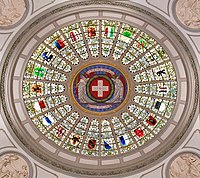Bern: Difference between revisions
Rmoving {{POV-title|date=July 2009}}. Even if you disagree with the move, the title is not a matter of POV, just a matter of spelling. |
Pmanderson (talk | contribs) restore; I believe the spelling to be a Germanist POV, and thoroughly improper. |
||
| Line 1: | Line 1: | ||
{{POV-title|date=July 2009}} |
|||
{{pp-move-vandalism|small=yes}} |
''{{pp-move-vandalism|small=yes}} |
||
{{Otheruses}} |
{{Otheruses}} |
||
{{Infobox Swiss town |
{{Infobox Swiss town |
||
Revision as of 20:29, 17 July 2009
Bern Berne Bärn | |
|---|---|
 Top left: Historical Museum, Top right: Federal Palace, Bottom: Aerial view of Bern | |
| Country | Switzerland |
| Canton | Bern |
| District | Bern |
| Government | |
| • Mayor | Stadtpräsident (list) Alexander Tschäppät SPS/PSS |
| Area | |
| • Total | 51.62 km2 (19.93 sq mi) |
| Elevation | 542 m (1,778 ft) |
| Highest elevation | 674 m (2,211 ft) |
| Lowest elevation (Aare) | 480 m (1,570 ft) |
| Population (31 December 2018)[2] | |
| • Total | 133,883 |
| • Density | 2,600/km2 (6,700/sq mi) |
| Demonym | Berner |
| Time zone | UTC+01:00 (Central European Time) |
| • Summer (DST) | UTC+02:00 (Central European Summer Time) |
| Postal code(s) | 3000 |
| SFOS number | 0351 |
| ISO 3166 code | CH-BE |
| Surrounded by | Bremgarten bei Bern, Frauenkappelen, Ittigen, Kirchlindach, Köniz, Mühleberg, Muri bei Bern, Neuenegg, Ostermundigen, Wohlen bei Bern, Zollikofen |
| Website | www SFSO statistics |
The city of Bern or Berne (German: Bern, pronounced [ˈbɛrn] ; French: Berne [bɛʀn]; Italian: Berna [ˈbɛrna]; Romansh: Berna [ˈbɛrnə]; Bernese German: Bärn [b̥æːrn]) is the Bundesstadt (federal city, de facto capital) of Switzerland, and, with a little less than 130,000 people (urban area: 200,000, agglomeration: 350,000), one of the five most populous cities in Switzerland. Bern is also the capital of the Canton of Bern, the second most populous of Switzerland's cantons.
The official language of Bern is German. The spoken language is the Swiss German dialect Bernese German.
The historic center of Bern has been featured in the list of UNESCO World Heritage Sites since 1983, and Bern is among the world’s top ten cities for the best quality of living.[3]
History
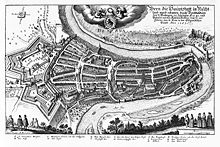
Duke Berchtold V of Zähringen founded the city on the River Aare in 1191 and allegedly named it after a bear (Bär in German) he had killed. It was made an Imperial Free City by the Holy Roman Emperor Frederick II in 1218 after Berthold died without an heir. In 1353 Bern joined the young Swiss Confederation, becoming a leading member of the confederation. It invaded and conquered Aargau in 1415 and Vaud in 1536, as well as other smaller territories, thereby becoming the largest city-state north of the Alps. It was occupied by French troops in 1798 during the French Revolutionary Wars, when it was stripped of parts of its territories. In 1831 the city became the capital of the Canton of Bern and in 1848 it additionally became the Swiss capital.
The city grew out towards the west of the boundaries of the peninsula formed by the river Aare. Initially, the Zytglogge tower marked the western boundary of the city from 1191 until 1256, when the Käfigturm took over this role until 1345, which, in turn, was then succeeded by the Christoffelturm (located close to today's train station) until 1622. During the time of the Thirty Years' War two new fortifications, the so-called big and small Schanze (entrenchment), were built to protect the whole area of the peninsula.
A number of congresses of the socialist First and Second Internationals were held in Bern, particularly during World War I when Switzerland was neutral. (See Bern International.)
Geography

Bern lies in the Swiss plateau within the Canton of Bern, somewhat west of the center of Switzerland and Template:Km to mi north of the Bernese Alps. The landscape around Bern was formed by glaciers in the last Ice Age. The two mountains closest to Bern are the Gurten with a height of Template:M to ft and the Bantiger with a height of Template:M to ft. The site of the old observatory in Bern is the point of origin of the CH1903 coordinate system at 46°57′08.66″N 7°26′22.50″E / 46.9524056°N 7.4395833°E.
The city was originally built on a hilly peninsully surrounded by the river Aare but outgrew these natural boundaries in the 19th century. A number of bridges were built to allow the city to grow beyond the Aare.
Bern is built on very uneven ground. There are several dozens of meters in height difference from the quarters on the Aare (Matte, Marzili) to the higher ones (Kirchenfeld, Länggasse).
Bern has an area of Template:Km2 to mi2. Of this area, 20.2% is used for agricultural purposes, while 33.5% is forested. Of the rest of the land, 44.2% is settled (buildings or roads) and the remainder (2.1%) is non-productive (rivers or glaciers).[4]
Subdivisions
The municipality is administratively subdivided into six districts (Stadtteile), each of which consists of several quarters (Quartiere).
Demographics
Bern has a population (as of 2008[update]) of 129,265, of which 21.7 % are foreign nationals. Most of the population (as of 2000[update]) speaks German (81.2%), with Italian being second most common (3.9%) and French being third (3.6%).
52.7 % of the population are female, 47.3 % are male. The average age is 41 years and nine months. As of 2000 children and teenagers (0–19 years old) make up 15.1%, adults (20–64 years old) 65% and seniors (over 64 years old) 19.9%.
The Swiss population is generally well educated. In Bern about 72.8% of the population (between age 25-64) have completed either non-mandatory upper secondary education or additional higher education (either University or a Fachhochschule).
Bern has an unemployment rate of 3.2%. As of 2005[update], there were 773 people employed in the primary economic sector and about 104 businesses involved in this sector. 16,484 people are employed in the secondary sector and there are 1,094 businesses in this sector. 131,659 people are employed in the tertiary sector, with 7,638 businesses in this sector.[4]
Politics
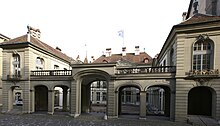
Bern is governed by the Gemeinderat, an executive council with five members, one of them the elected mayor (Stadtpräsident). The parliament has 80 members and is called Stadtrat. Both the legislative and the executive are elected in general elections for a term of four years. The last elections were held in November 2008 with a 43.48% participation.
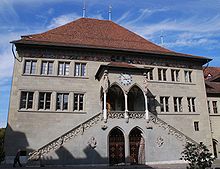
The executive council has a left-green majority with two representatives, including the mayor Alexander Tschäppät, of the Social Democratic Party of Switzerland (SPS) and one representative of the leftist Green party Grünes Bündnis (GB). It also has a majority of three woman against two men.
The seat of the Gemeinderat is the Erlacherhof.
The 80 members of the legislative council belong to 18 different political parties, the strongest beeing the Social Democratic Party with 20 representatives, followed by the conservative Free Democratic Party of Switzerland (FDP) with 10 and the moderate Green party Grüne Freien Liste (GFL) with 9 seats. Both the far right Swiss People's Party (SVP) and the leftist Green party Grünes Bündnis have 8 seats each.
The Stadtrat meets on thursday evenings at the Rathaus (Town Hall).
The representatives of the Social Democratic Party and of the Green Parties, collectively referred to as "Red-Green-Center" (Rot-Grüne-Mitte), hold a majority in both councils and mostly determine City policy, although no formal coalition agreement exists and, under the system of direct democracy that prevails in Switzerland, most important issues are settled by general vote.
Main sights
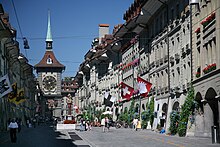

The structure of Bern's city center is largely medieval and has been recognised by UNESCO as a Cultural World Heritage Site. Perhaps its most famous sight is the Zytglogge (Bernese German for "Time Bell"), an elaborate medieval clock tower with moving puppets. It also has an impressive 15th century Gothic cathedral, the Münster, and a 15th century town hall. Thanks to 6 kilometers of arcades, the old town boasts one of the longest covered shopping promenades in Europe.
Since the 16th century, the city has had a bear pit (the Bärengraben). The current pit off the far end of the Nydeggbrücke no longer contains any bears, the last being put down in 2009,[5] shortly before the opening of the new bear pit later in the year.
The Federal Palace (Bundeshaus), built from 1857 to 1902, which houses the national parliament, government and part of the federal administration, can also be visited.
Einstein lived in an apartment at the Kramgasse 49, the site of the Einsteinhaus, from 1903 to 1905, the year in which the Annus Mirabilis Papers were published.
The Garden of Roses (Rosengarten), from where a scenic panorama view of the medieval city core can be enjoyed, is a well-kept Rosary on a hill, converted into a park from a former cemetery in 1913.
Bern's most recent sight is the set of fountains in front of the Federal Palace. It was inaugurated on August 1, 2004.
Bern features many heritage sites of national significance.[6] Apart from the entire Old Town and many sites within it, these include the Bärengraben, the Gewerbeschule Bern (1937), the Eidgenössisches Archiv für Denkmalpflege, the Kirchenfeld mansion district (after 1881), the Thunplatzbrunnen, the Federal Mint building, the Federal Archives, the Swiss National Library, the Historical Museum (1894), Alpine Museum, Museum of Communication and Natural History Museum.
Culture


Theaters
- Bern Theatre[7]
- Narrenpack Theater Bern[8]
- Schlachthaus-theater[9]
- Tojo Theater
- The Theater on the Effinger-Street[10]
- Theater am Käfigturm[11]
Movie theaters
Bern has several dozen movie theaters. As is customary in Switzerland, movies are generally shown in their original language (e.g., English) with subtitling in German and French. Only a small number of screenings are dubbed in German.
- Queersicht - gay and lesbian film festival, held annually in the second week of November.
Festivals
- BeJazz Summer and Winter Festival
- Buskers festival
- Gurtenfestival
- Internationales Jazzfestival Bern
- Queersicht - Queer Filmfestival, annually held second week of November.
- Taktlos-Festival
Fairs
- Zibelemärit - The Zibelemärit (onion market) is an annual fair held on the fourth Monday in November.
Sport

The football team BSC Young Boys is based in Bern at the Stade de Suisse Wankdorf, which also is one of the venues for the European football championship.
The Stade de Suisse hosted a number of matches during the 2008 UEFA Euro Cup tournament.
SC Bern is the major ice hockey team of Bern who plays at the PostFinance Arena.
The PostFinance Arena will be main host of the 2009 IIHF Ice Hockey World Championship, including the opening game and the final of the tournament.
Bern Cardinals is the baseball and softball team of Bern, which plays at the Allmend
Bern Grizzlies is the American football club in Bern and plays at Sportanlage Schonau.
Bern was a candidate to host the 2010 Winter Olympics, but withdrew its bid in September 2002 after a referendum was passed that showed that the bid was not supported by locals. Those games were eventually awarded to Vancouver, Canada.
Education
Bern has a University, a University of Applied Science and several vocational schools.
The University of Bern is spread over several buildings which are mainly located in the Länggasse quarter.
The University of Applied Science (Fachhochschule) is also located in Bern.
Transport

Bern is well connected to other cities by several highways (A1, A12, A6).
Public transport works well in Bern, with tram, S-Bahn and bus lines which connect the different parts of the City. Bern Rail Station connects the City to the national and international train network. A funicular leads from the Marzili quarter to the Bundeshaus. This funicular is, with a length of 106 m, the second shortest public railway in Europe after the Zagreb Funicular. Several Aar bridges connect the old parts of the city with the newer quarters outside of the peninsula.
Bern is served by Bern Airport, located outside the city near the village of Belp. The regional airport, colloquially called Bern-Belp or Belpmoos, is connected to several Swiss and European cities.
Weather
| Climate data for Bern | |||||||||||||
|---|---|---|---|---|---|---|---|---|---|---|---|---|---|
| Month | Jan | Feb | Mar | Apr | May | Jun | Jul | Aug | Sep | Oct | Nov | Dec | Year |
| Source: MeteoSchweiz [12] | |||||||||||||
Miscellaneous
- The Universal Postal Union is situated in Bern.
- Bern was featured as one of the scenarios in the original SimCity video game
- The city of New Bern, North Carolina in the USA is named after Bern, having been founded in 1710 by Christoph von Graffenried, a minor Swiss noble from Bern who attempted to set up Swiss settlement in the New World.
- The German-born physicist Albert Einstein worked out his theory of relativity while employed as a clerk at the Bern patent office.
Notable people
- Mikhail Bakunin died in Bern on July 1, 1876
- Albert Einstein worked out his theory of relativity while living in Bern, employed as a clerk at the patent office
- Albrecht von Haller
- Ferdinand Hodler
- Paul Klee
- Mani Matter, songwriter
External links
- City of Bern
- Bern (Gemeinde) in German, French and Italian in the online Historical Dictionary of Switzerland.
- GIS City of Bern
- Bern Public Transportation Website (BernMobil)
- Template:Wikitravel
- CityHunter Bern
- Gurtenfestival
References
- ^ a b "Arealstatistik Standard - Gemeinden nach 4 Hauptbereichen". Federal Statistical Office. Retrieved 13 January 2019.
- ^ . Federal Statistical Office https://www.pxweb.bfs.admin.ch/pxweb/de/. Retrieved 15 June 2020.
{{cite web}}: Missing or empty|title=(help) - ^ Quality of Living global city rankings – Mercer survey
- ^ a b Swiss Federal Statistical Office accessed 29-May-2009
- ^ [1] "Old age overtakes an ages old tradition"], April 30, 2009
- ^ Swiss inventory of cultural property of national and regional significance (1995), p. 103–105.
- ^ "Stadttheater Bern". Retrieved 2009-04-12.
- ^ "Narrenpack Theatre Bern". Retrieved 2009-04-12.
- ^ "Schlachthaus Theatre Bern". Retrieved 2009-04-12.
- ^ "Das Theatre an der Effingerstrasse". Retrieved 2009-04-12.
- ^ "Theater am Käfigturm". Retrieved 2009-04-12.
- ^ "Average Values-Table, 1961-1990" (in German, French, and Italian). Federal Office of Meteorology and Climatology MeteoSwiss. Retrieved 8 May 2009.







